Massachusetts Shop Implements Machine Monitoring and Realizes Its ROI in Only 60 Days
AccuRounds, a family-owned manufacturing company, decided to install a machine monitoring system. In a continuous effort to build a strong culture from the front office to the shop floor, the leadership team worked diligently to manage the tensions and skepticism that came from employees during the first few months after installation.

AccuRounds supplies quality precision turned components for leading OEMs worldwide.
AccuRounds is a second-generation, family-owned, advanced manufacturer based in Avon, Massachusetts. Established in 1976, they provide custom, precision-machined components to industries including medical, aerospace, and emerging technologies.
In 2017, AccuRounds began talks with MachineMetrics and installed their machine monitoring system on ten CNC machines in January 2018. Within a year, they had connected twenty-three machines and were driving process improvements and greater collaboration between engineers and machinists.
Recently. Mike Tamasi, AccuRounds President and CEO, and some other employees sat down to discuss the MachineMetrics implementation.
How would you describe how AccuRounds' culture is supported and enacted on a daily basis?
Mike: My door is open 95% of the time. I walk the floor multiple times a day, interacting with team members. Machinists have the opportunity to address me. Now, I know that could be intimidating for some people, but I try to make sure that I'm approachable, and I think that's important for our entire executive team to understand -- that they need to be approachable.
VIDEO: AccuRounds manufactures complex components for applications that require critical dimensions.
We have idea boards, we have scheduled meetings, we have daily huddles -- all to drive engagement and collaboration. Hopefully our team sees that and understands it. If people can trust other people, then they're not intimidated to ask questions or make suggestions or address concerns.
What goals were you hoping to achieve by implementing a machine monitoring system?
Jim: Measuring the efficiency of the process on the machines, that was the end goal. At one point we were doing that by hand, on paper, hourly, and my feet live to tell about it. It was not the most efficient, but it was still eye-opening, because you realize how inefficient you really are. When I know the problem, I can put the right person with the machinist. They'll get training, they'll get experience, they'll solve the problem, the company will make money, and you won't lose these big chunks of time.
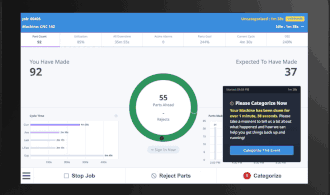
MachineMetrics' Platform has automated machine data collection and production analytics to deliver data-driven insights in a matter of minutes.
Paul: You would go out on the floor, and they would say, "Things are running well." You would take their word for it. Come to find out things are not running well. The biggest thing was, if a job was scheduled to run for three days, we just expected on that third day for it to be done. If it wasn't, then maybe that's when we would interact with that operator. We were beginning to realize how important it was to track that.
How did you prepare for and roll out your MachineMetrics installation?
Mike: We talked it up a little bit beforehand. I don't think people really grasped what this was going to be until they said, "Oh, there's a tablet in front of me. Wow, look at the color, and what does that all mean?" We only started with the ten machines that we thought were the better performers, that would be easier to get the implementation up and would yield less resistance. We were targeting our more progressive individuals that we felt would grasp and welcome this technology versus people that just would have a difficult time understanding it. You want to go for the easy ones first.
What were the challenges you anticipated?
Mike: I think one of the challenges through implementation was getting past the whole human element of, "Why are you watching what I'm doing?" There was a lot of coaching that took place to get past that. We have some individuals that run two machines, and it might be tough to keep two machines green, so they were upset that one was red. They knew they couldn't get into green, and they thought they were going to get penalized for it, when the reality is no, you're producing something at 50% versus zero. So, you're getting 150% production versus nothing on that second machine. And that's okay.
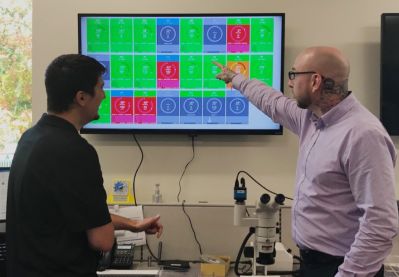
Accurounds' process engineers Paul and Jake are reviewing MachineMetric's real-time dashboards.
Jake: I would say that there is also an age gap, a generation gap, and a language gap. When you get the younger generation that's tablet-driven, and app-driven, and data-driven, they're more apt to think of it as a tool, versus an older generation, the only person they ever answered to was one supervisor. Now they have a tablet watching what they do at every machine. You're trying to explain to him, "No, we're not watching what you're doing to get you. We're watching the process and watching the job."
Mike: And are we responding to what the tablet is telling our team? Are we providing them the resources that would make the improvements needed to get something from red or orange to green? So, if we're not reacting, if we're not communicating with them, and they're not seeing the benefit, and I'm not talking about it at meetings on what it's done for us, then it could become a turnoff for all involved, and they're not paying as much attention to it as we'd like them to.
What about from the operator perspective?
Machinist 1: The more information they have, the better they can make decisions. There's never too much information in a place like this. Like Mike says, the biggest thing is having spindles running. Even if we notice a small thing, it might be an ongoing issue we have.
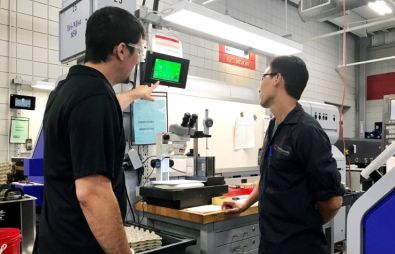
Paul discussing run rates offered in MachineMetric's Operator View with Thu, a machine operator.
Machinist 2: It's pretty cool. We had it at my old company, but only the supervisors could see it, so they would know when the machine is off. It's cool that we can see it too, so we know if we’re behind.
Machinist 3: If I'm doing the right thing, I don't care how they measure it. I will put what information I have to. It's not measuring me, it's measuring the process. If it's red, there's less chance for a bonus, but I don't panic. Sometimes it's a mismatch, the wrong expected time, or a tool that takes longer. It may depend on if they're experimenting with tooling. We're always trying to improve the process.
Machinist 4: It's great. You can see the effects of the change in the process, and it's more information for me. But if I’m running two machines, I don't have time. I try to give them all the information because it's important, but it gets to the point where you have too many things to do and you can't.
Machinist 5: This sends them correct information, rather than waiting until the end of the day and seeing that you were supposed to make 500 but only made 400. Some guys let it affect them, like, "Oh they're watching me," but I figure if they're watching you, they're watching you. I do check to make sure it's working accurately. If the cycle time says 50 but I'm only making 45, they need to know it. For me, it's kind of like paperwork, just another thing. But one positive thing is the hour-by-hour information on cycle time. It's direct information there right where you need it.
What have been the benefits of MachineMetrics for engineers and managers?
Jon: I can see how the job ran hour-to-hour. The whole shop used to do a paper system, but with that, you're not evaluating the process at all, and you're adding administrative work that no one does anything with. MachineMetrics eliminates all that. It shows if a machine is running and what's going on. We build confidence in our processes when I see consistent data.
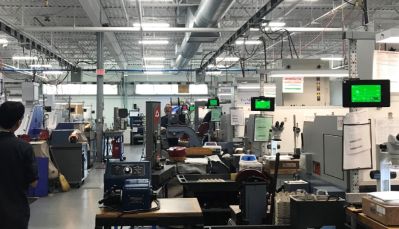
MachineMetric's Operator View in action, throughout AccuRound's shop floor.
Sonia: What has helped a lot is rates and seeing that real-time rather than when the job ends. It has also helped, as far as looking at the history. Okay, we ran this job so many times and there continues to be issues. What's going on?
Paul: For us, it's a pareto chart to see where training needs to be focused. If downtime is because they're doing a tool change and I'm noticing it's taking them 30 minutes to change a tool, maybe you can retrain that operator to have it become a five-minute change. They're probably not comfortable or not confident enough to change the tool really quick. I've seen a few of those.
Jake: It helped us to identify problem jobs and problem processes in a much more organized fashion. Before, I don’t really think we were capturing the information. It was more of, "Why didn't this run right?" And then we'd go back to the machinist after he was two or three jobs past that and say, "What was the issue with this?" And they'd say, "I don’t remember, I mean I already set up three jobs between then and now." With MachineMetrics, they can put notes within the downtime categories and say, "This is what happened."
VIDEO: The MachineMetrics Industrial IoT Platform
Mike: MachineMetrics is another vehicle to have a discussion, a dialogue. It's a tool to help keep spindles running, and that's what we're paid to do. It's enhanced the culture for sure. We've seen it. It’s allowed us to identify issues quicker and get them resolved quicker.
What else have you done to leverage MachineMetrics to support and transform the culture at AccuRounds?
Sonia: I like to always look at the data before I actually go out on the floor, so I know what I'm talking about and it's not like a surprise to me. I don't like going out there without having some information, some insight of what's going on. The guys on the floor, they don't remember every single work order. They run so many orders, so I've got to show them the data. Four work orders ago, this is how it ran, this is who set it up. And then it comes back to them. They figure out, okay, this is what happened.
Mike: I've coached people up on what certain percentages mean and how they're calculated and then ultimately talked about the result of what green means across the board for the entire company ultimately better performance, satisfying the customer, more money in your pocket through a bonus check.
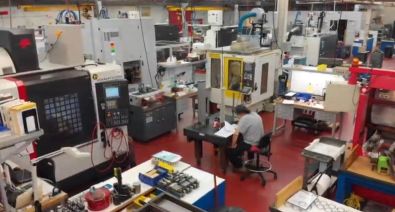
With the latest in CNC turning and milling technologies, AccuRounds offers a variety of state-of-the-art options for manufacturing high precision components.
So, it just opens up the opportunity for more dialogue, more awareness, more communication to process improve. And that's really all we want. We want more engagement and we want a higher level of engagement. And this tool gives us the opportunity to do that.
Jim: Based on the process and how it should be running, you should be running 85 to 90% or better, which puts it in the green, which keeps everybody happy. If it's not running there, are you having a problem with the machine? Is it the process that broke down? Did we do something that caused a failure and didn't set you up to succeed? Because we've had that happen too, where it's not the fault of the operator that we didn't have a tool in stock or it wasn't where it should've been.
Jake: Being a machinist myself for over a decade and then coming into engineering, I can tell you, you take pride in what you do. You take faith that you're hired to be trusted in what you do. So, when someone's coming and going, "Hey, I noticed you're red...," Immediately you just go on the defense. If they're running at 60% and it's in the red, it usually prompts me to go out and talk with the operator to say, "You having an issue?" But if you just say, "Hey, why is it in the red? Why?" Immediately they're going to be like, "Why do you care?" Or, "I don't answer to you," But if I go out to them and say, "If you're having issues, we'll get you more resources," or something like that, then they're more apt to go, "All right." And it's not just a red flag.
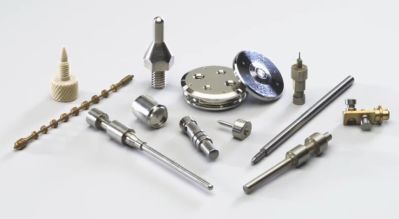
Accurounds manufactures extremely precise components.
Paul: It's actually more insight without having to look over an operator's shoulder. You don’t want to just feel like you're looking over everyone's shoulder. You want to give them the freedom to run the parts. They know the job, they're doing the job well.
What advice would you give to other companies on how to successfully support an implementation?
Mike: The first piece of advice is, make sure it's right for you. Make sure you have the culture that's going to embrace it ultimately. And start small. Don't try to do the whole shop. Then celebrate the wins. Celebrate the opportunities for improvement. Communicate, communicate, communicate. Let the team know what the potential is, and just continue to keep that in front of your entire team because you can't just make the splash and walk away. You've got to constantly talk about what that tool is doing for you and the opportunities that are opening up to present themselves that make the company better. Because that's ultimately what we're after. Everybody wants the same thing. We want to be successful, and we want to make sure that our jobs are going to be there in the future.
What does the future hold for MachineMetrics at AccuRounds?
Mike: We've had some pretty good months where we can point to the fact that our utilization was up and that's driving our costs down, which again plays into the opportunity for everyone to get a better bonus at the end of the year. We want to grow; we want controlled growth every year. Part of that growth will be the need for some type of data analytics activity to take place in our organization. And maybe, ultimately we can get to the point where we're providing machinists with some reports and information that are going to help them understand the data better, which would facilitate more ideas and improvement.
My number one job is to make sure people understand what behaviors are expected at AccuRounds. How can I help coach them to be a better team player, and what can we do to help them be a better team player? Understanding and implementing tools like MachineMetrics is going to help us get there: integrating automation, robotics, 3D printing, big data -- with MachineMetrics and other tools. Those are the types of things that are going to facilitate machinists' workdays and make them work smarter, not harder.
Want more information? Click below.
Rate this article
View our terms of use and privacy policy